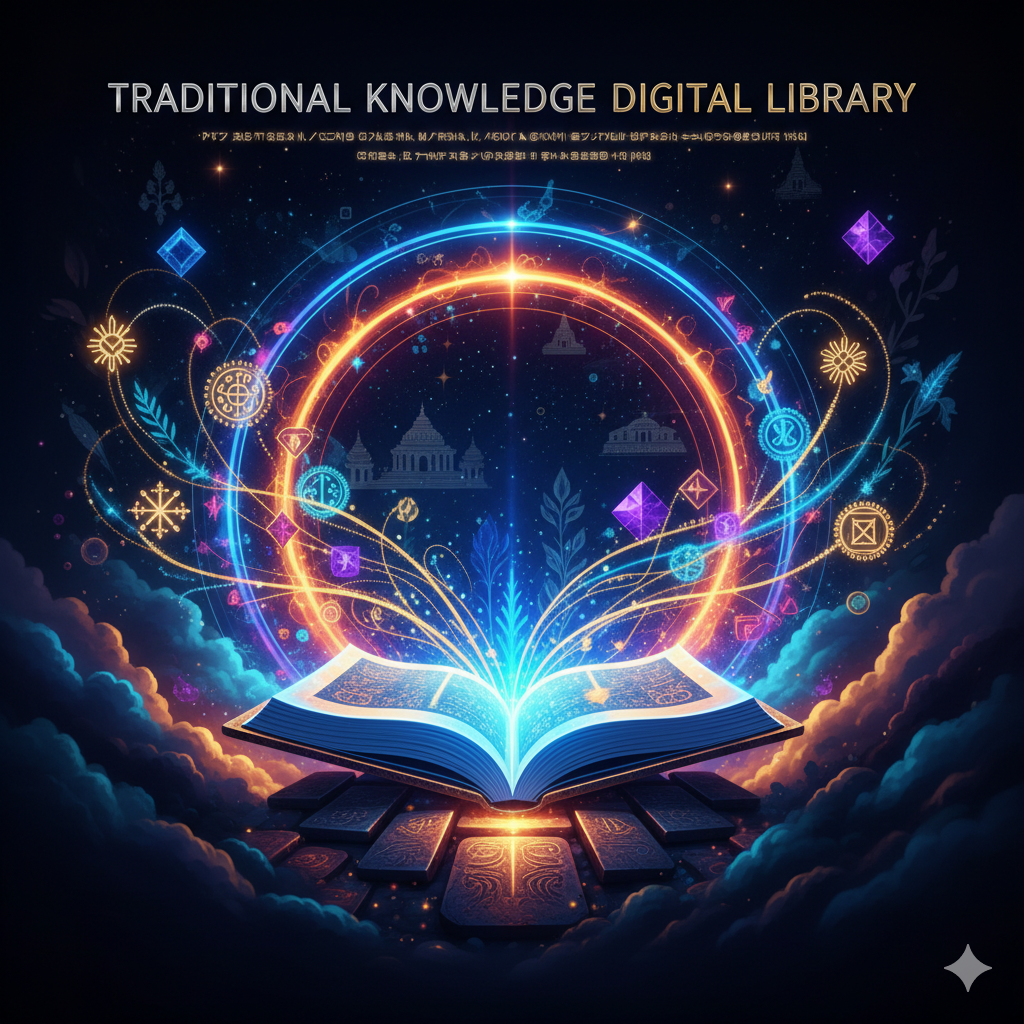Introduction
India has long been recognized as one of the richest repositories of traditional knowledge (TK) in the world. Its ancient texts, oral traditions, folk medicine systems, and traditional healing practices have contributed significantly to global health and wellness. However, this rich heritage has often been exploited by foreign entities through the process of biopiracy—where biological resources or traditional knowledge are patented without appropriate authorization or benefit-sharing with the original knowledge holders.
To counter this trend, India established the Traditional Knowledge Digital Library (TKDL) in 2001 as a pioneering initiative to protect the country’s traditional medicinal knowledge from misappropriation. The TKDL contains meticulously translated and digitized information derived from ancient texts such as Ayurveda, Unani, Siddha, and Yoga. It now holds over 2 million formulations and serves as a bridge between traditional knowledge and modern intellectual property rights (IPR) systems.
However, with the increasing demand for open data and global collaboration in scientific research, there has been growing debate about whether the TKDL should be made publicly available under open-source licensing. While such openness could promote innovation, research, and global recognition of India’s traditional systems, it also poses potential risks of misuse and commercialization without due acknowledgment or compensation.
This essay examines the benefits and challenges of making the TKDL publicly available, evaluates the legal, ethical, and socio-economic implications, and discusses potential policy options to balance openness with protection.
1. Understanding the Traditional Knowledge Digital Library (TKDL)
1.1 Genesis and Purpose
The TKDL was conceptualized jointly by the Council of Scientific and Industrial Research (CSIR) and the Ministry of AYUSH after India faced several cases of biopiracy in the 1990s, such as:
- Turmeric patent case (1995): The U.S. Patent Office granted a patent for wound-healing properties of turmeric, which had been known in Indian households for centuries.
- Neem patent case (1994): A European company patented neem-based fungicides, again derived from traditional Indian practices.
- Basmati rice patent case (1997): A U.S. company attempted to patent basmati rice varieties grown in India and Pakistan.
These incidents highlighted the vulnerability of India’s traditional knowledge to exploitation and the lack of formal documentation that could be recognized by patent examiners worldwide.
1.2 Structure and Features
The TKDL digitizes traditional medicinal knowledge from Ayurveda, Unani, Siddha, and Yoga texts written in Sanskrit, Arabic, Persian, Urdu, and Tamil. These are translated into five international languages—English, French, German, Spanish, and Japanese—and formatted according to the standards of international patent classification systems such as the International Patent Classification (IPC) and Traditional Knowledge Resource Classification (TKRC).
The TKDL is accessible under restricted agreements to selected international patent offices like:
- European Patent Office (EPO)
- United States Patent and Trademark Office (USPTO)
- United Kingdom Patent Office (UKPO)
- Canadian Intellectual Property Office (CIPO)
- German Patent Office (DPMA)
Access is limited to patent examiners to prevent the granting of erroneous patents based on traditional knowledge.
2. The Role of TKDL in Preventing Biopiracy
The TKDL has proved to be an effective deterrent against biopiracy. By providing patent examiners access to credible prior art, it ensures that patents are not granted for inventions that already exist within traditional systems of knowledge.
2.1 Major Success Stories
- Turmeric patent revoked: TKDL provided documentary evidence from ancient Ayurvedic texts that turmeric was traditionally used for wound healing, leading to patent revocation.
- Neem patent overturned: Similarly, the EPO revoked a patent on neem-based products citing TKDL evidence.
- More than 200 patent applications withdrawn or rejected: TKDL has prevented the granting of several patents globally related to yoga postures, medicinal plants, and traditional formulations.
2.2 Global Recognition
The TKDL has been hailed by the World Intellectual Property Organization (WIPO) as a model framework for protecting traditional knowledge. Several countries such as China, Peru, and Indonesia have expressed interest in replicating this model.
3. The Debate: Should TKDL be Open to the Public?
The key question today revolves around access—should the TKDL, which has successfully safeguarded India’s traditional knowledge from misappropriation, be made publicly accessible under open-source licensing?
The argument has two major sides:
- Proponents of openness argue that open-source access could enhance scientific research, global recognition, and innovation.
- Opponents of openness warn that it could lead to renewed exploitation and commercialization without consent or benefit-sharing.
Let us now examine both perspectives in depth.
4. Advantages of Making TKDL Publicly Available
4.1 Promotion of Scientific Research and Innovation
Opening the TKDL database could allow researchers, pharmaceutical companies, and universities worldwide to access vast amounts of data on traditional formulations. This could lead to:
- Drug discovery and development: Researchers could identify promising compounds or formulations for modern therapeutic applications.
- Integrative medicine: Facilitates collaboration between traditional and modern medicine systems, promoting holistic healthcare.
- Evidence-based validation: Scientists could test and validate traditional claims through modern research, enhancing credibility.
For example, the anti-cancer properties of certain Ayurvedic herbs like Ashwagandha or Guduchi could be explored further when researchers have access to detailed traditional formulations.
4.2 Recognition of India’s Knowledge Heritage
Open access would help promote India’s traditional systems globally, fostering cultural pride and soft power. It could lead to increased recognition of Ayurveda and other traditional systems in international health frameworks such as WHO’s Traditional Medicine Strategy (2014–2023).
4.3 Educational and Academic Utility
Public access would greatly benefit students, academicians, and practitioners. It would serve as a vast learning resource for studies in ethnobotany, pharmacology, anthropology, and intellectual property law.
4.4 Economic Opportunities
With an open database, entrepreneurs could develop innovative wellness products, nutraceuticals, and cosmetics based on documented traditional knowledge. This could boost India’s AYUSH industry, create employment, and enhance exports.
4.5 International Collaboration
Open-source licensing could promote collaborative research projects between Indian institutions and global organizations. For example, partnerships between CSIR and global pharma companies could advance new drug pipelines with shared benefits.
4.6 Transparency and Global Integration
Making TKDL open aligns with global trends toward open science and knowledge democratization. Many scientific databases, like the Human Genome Project, have driven rapid innovation by being freely accessible.
5. Risks and Challenges of Open-Source Access
While openness has benefits, it comes with significant risks, especially for a knowledge base as culturally and economically sensitive as TKDL.
5.1 Risk of Misappropriation and Commercial Exploitation
Once made public, TKDL’s content could be commercially exploited by corporations or individuals without authorization. Even with open-source licenses, enforcing compliance globally is challenging. Traditional communities, who are the original custodians, might not receive fair benefit-sharing.
For instance, pharmaceutical companies could extract active compounds from traditional formulations, modify them slightly, and file new patents, bypassing the spirit of TK protection.
5.2 Dilution of Cultural and Ethical Values
Traditional knowledge is not merely scientific—it is embedded in cultural, spiritual, and ethical contexts. Making it open to anyone, anywhere, could lead to cultural appropriation or misuse, stripping knowledge of its original meaning and sanctity.
5.3 Loss of Competitive Advantage
India currently holds a strategic advantage by having a comprehensive TKDL accessible only to patent offices. If made open, other countries might copy or replicate parts of the database, diluting India’s intellectual leadership in the domain.
5.4 Challenges in Data Interpretation
Traditional formulations are often context-dependent—the efficacy varies based on environmental, dosha (body type), and preparation conditions. Non-experts might misinterpret these formulations, leading to misuse or health risks.
5.5 Legal Complexities and Global Enforcement
Open-source licensing would require clear legal frameworks for attribution, benefit-sharing, and restrictions on commercial use. Enforcing such provisions internationally would be legally complex and resource-intensive.
5.6 Potential Violation of Biodiversity Laws
The Biological Diversity Act (2002) and the Nagoya Protocol (2010) mandate fair and equitable benefit-sharing from biological resources. Open access to TKDL might contradict these principles by enabling use without formal benefit-sharing mechanisms.
5.7 Undermining of Indigenous Rights
Indigenous communities, who have passed down knowledge through generations, may lose control over their heritage if it becomes globally accessible. It could lead to alienation and resentment among traditional healers and local practitioners.
6. Balancing Openness and Protection: Policy Considerations
6.1 Controlled or Tiered Access
A balanced approach could involve tiered access mechanisms:
- Restricted access for patent examiners (as currently practiced).
- Controlled access for researchers and educational institutions under strict non-commercial licenses.
- Public access to limited metadata or summaries, not full formulations.
This would allow knowledge sharing while safeguarding sensitive details.
6.2 Strengthening Legal Safeguards
Before opening TKDL, India must strengthen legal instruments for protecting traditional knowledge:
- Sui generis laws for traditional knowledge protection.
- Mandatory benefit-sharing clauses for any commercial use.
- International agreements to recognize India’s ownership of TKDL data.
6.3 Digital Rights Management (DRM) and Licensing Models
Implementing DRM technologies can help track and control how TKDL data is accessed and used. Open licenses could include clauses such as:
- “For research and education only.”
- “Commercial use requires prior approval and benefit-sharing.”
6.4 Involvement of Traditional Healers and Communities
Decision-making about access should involve representatives of traditional communities. This ensures ethical respect and participatory governance of TKDL resources.
6.5 Collaboration with WIPO and WHO
India can collaborate with WIPO and WHO to design global protocols for open yet protected access to traditional knowledge databases. This could become an international model for other nations.
6.6 Public Awareness and Capacity Building
Educating the public and researchers about ethical use of traditional knowledge is vital. Awareness programs and academic courses on intellectual property and indigenous knowledge can prevent misuse.
7. Comparative Analysis: Global Experiences with Traditional Knowledge Databases
Several countries have initiated similar projects, offering insights for India.
7.1 China’s Traditional Chinese Medicine (TCM) Database
China has digitized vast records of TCM and made certain parts publicly available. However, they maintain strong government control over critical data, ensuring that commercialization is regulated.
7.2 Peru’s National Commission for Biopiracy
Peru maintains a national register of traditional knowledge and uses it to challenge biopiracy claims. Public access is limited to summaries, not full details of formulations.
7.3 African Union’s TK Protection Framework
African countries advocate for a community-based rights approach, emphasizing that any use of traditional knowledge must ensure benefit-sharing with local communities.
7.4 Lessons for India
India can adopt a hybrid model, combining public visibility with restricted technical access—thus promoting awareness while ensuring protection from exploitation.
8. Future Prospects and Way Forward
The TKDL stands at a critical juncture. As global demand for natural and traditional medicines grows, the need for scientific collaboration also increases. Therefore, India’s approach must evolve with time while maintaining core principles of sovereignty, ethics, and equity.
8.1 Integration with Digital India and AI Tools
The TKDL can be enhanced using Artificial Intelligence (AI) and machine learning tools to:
- Identify potential drug leads.
- Predict biological activities of compounds.
- Cross-reference traditional formulations with modern research databases.
Such integration could transform TKDL into a dynamic research platform rather than a static database.
8.2 International Recognition of TKDL-Based Prior Art
India should advocate at WIPO and TRIPS forums to ensure that TKDL evidence is recognized as valid prior art globally. This will strengthen its legal enforceability against wrongful patents.
8.3 Collaboration with AYUSH Industry and Pharma Companies
Public-private partnerships can promote ethical commercialization of TKDL-based products, ensuring that revenues are shared with traditional communities through benefit-sharing funds.
8.4 Incorporating Traditional Knowledge into National Education
Including TKDL information in academic curricula can help students understand the scientific foundation and cultural depth of Indian traditional systems. This fosters respect for indigenous knowledge.
9. Conclusion
India’s Traditional Knowledge Digital Library (TKDL) is one of the most remarkable innovations in the global intellectual property landscape. It bridges the gap between ancient wisdom and modern legal frameworks, successfully protecting India’s traditional heritage from biopiracy and misuse.
The debate on making TKDL publicly available under open-source licensing encapsulates a larger dilemma between knowledge accessibility and knowledge protection. While open access could accelerate research, foster global collaboration, and enhance India’s cultural soft power, it also risks exposing sensitive knowledge to exploitation and commercialization without due benefits to the rightful custodians.
Therefore, a balanced approach is essential—one that ensures transparency and academic access while preserving ownership, cultural integrity, and equitable benefit-sharing. Controlled access mechanisms, robust legal safeguards, and participatory governance involving traditional communities offer a practical middle path.
In the long run, the TKDL should not just remain a defensive tool against biopiracy but evolve into a living repository of innovation, culture, and sustainability—a bridge connecting ancient Indian wisdom with the global pursuit of scientific and ethical progress.
Summary of Key Points
| Aspect | Benefits of Open Access | Risks/Challenges |
|---|---|---|
| Research and Innovation | Promotes global collaboration and drug discovery | Risk of misappropriation and misuse |
| Cultural Recognition | Showcases India’s heritage worldwide | Possible cultural dilution |
| Economic Impact | New opportunities in AYUSH and wellness sectors | Loss of competitive advantage |
| Legal and Ethical Concerns | Supports transparency and open science | Complex enforcement and benefit-sharing issues |
| Best Solution | Controlled or tiered access with legal safeguards | — |
Educational Takeaway
The case of TKDL demonstrates the interplay between intellectual property, traditional knowledge, and global justice. It teaches how modern digital tools can be harnessed to protect indigenous heritage, and how nations must constantly negotiate between open innovation and cultural preservation in an interconnected world.




